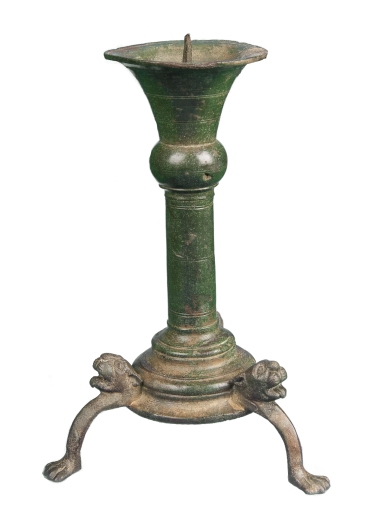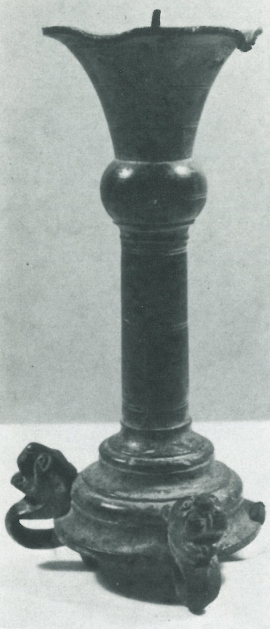My previous post looked at the fascinating memorial to Aurelia Concessa from Branston, and I’d like to do something of a follow up post here by highlighting another significant find made not too far away from it. This particular object is a complete copper alloy candlestick – a rare find from Roman Britain, and one with potential religious connotations.
The candlestick was discovered in November 1973 during agricultural work. Sadly the exact findspot is not known as it was found by a potato harvesting machine but not immediately noticed. All that can be said is that it came from the field centred on TF039676 (Moore 1975). This location is on the eastern side of Branston, and just over 2 miles east of the findspot of the Aurelia Concessa inscription.

The candlestick is a fine example of its type, the lead-filled shaft decorated with a collar, bands of incised lines, and topped with a lily-shaped drip pan. The candlestick stands on three legs, each decorated with a characterful panther head, mouth open and tongue lolling. When found, two coins were wedged inside the drip pan against the prick, of which more below.
Candlesticks increasingly replaced oils lamps as the preferred form of lighting in Roman Britain during the 3rd and 4th Centuries (Eckardt 2011). Candlesticks occur more commonly in ceramic and iron, but more rarely in copper alloy. This example most likely dates to the later 3rd or early 4th Century.
The story of this particular candlestick does not end there, however, as its current appearance is the result of conservation work following its discovery – work that I doubt would have been carried out in the same manner had the candlestick been discovered today. When found, the candlestick was suffering from some plough damage; the drip tray was bent and one leg was missing. The two remaining legs were bent underneath the body, something that the British Museum’s Research Laboratory (who carried out the reconstruction) observed to have been an act carried out in antiquity (Moore 1975).

This deliberate bending of the legs, when combined with the two coins that were found wedged inside the drip pan, suggests that the deposition of the candlestick was something more than a casual loss, and the reconstruction of it to its original appearance actually a rather invasive act, serving to reverse an important part of the object’s story.
The two coins were Gloria Exercitus issues of Constantine II (AD337-340), and both showed little sign of wear, suggesting that the candlestick was deposited in the ground in the mid 4th Century. The act of deliberately damaging the candlestick to render it unusable is indicative of a practice widely attested in votive depositions across many cultures from the Bronze Age onwards.
The connections between light sources and temples are well attested, with both practical and symbolic lighting being provided. Eckardt (2011) particularly noted the discovery of lighting equipment at British sanctuaries connected to eastern ‘mystery cults’ such as those of Cybele and Mithras. The panther head imagery on the Branston candlestick may therefore be of significance, as the panther was an attribute of the god Bacchus, a god whose cult was intimately connected with death and rebirth, and who has been found connected with other mystery cults, for example at the Walbrook Mithraeum in London.
This beautiful candlestick therefore may have a history beyond simply being an attractive and functional household object. Perhaps it served as a lighting source within a shrine before being put beyond practical use and carefully buried, maybe at the time the shrine itself was closed – the mid 4th Century was after all a time when pagan religions were coming under increased threat from the growth of Christianity.
It certainly serves as an example of how archaeological objects could have multiple ‘lives’, and that what may at first appear to be damage may in fact be an important aspect of its story.
References
Eckardt, H. 2011. Heating and Lighting. In Allason-Jones, L. (Ed.) Artefacts in Roman Britain: Their purpose and use. Cambridge
Moore, N. 1975. A Roman bronze candlestick from Branston, Lincolnshire. Britannia Vol 6